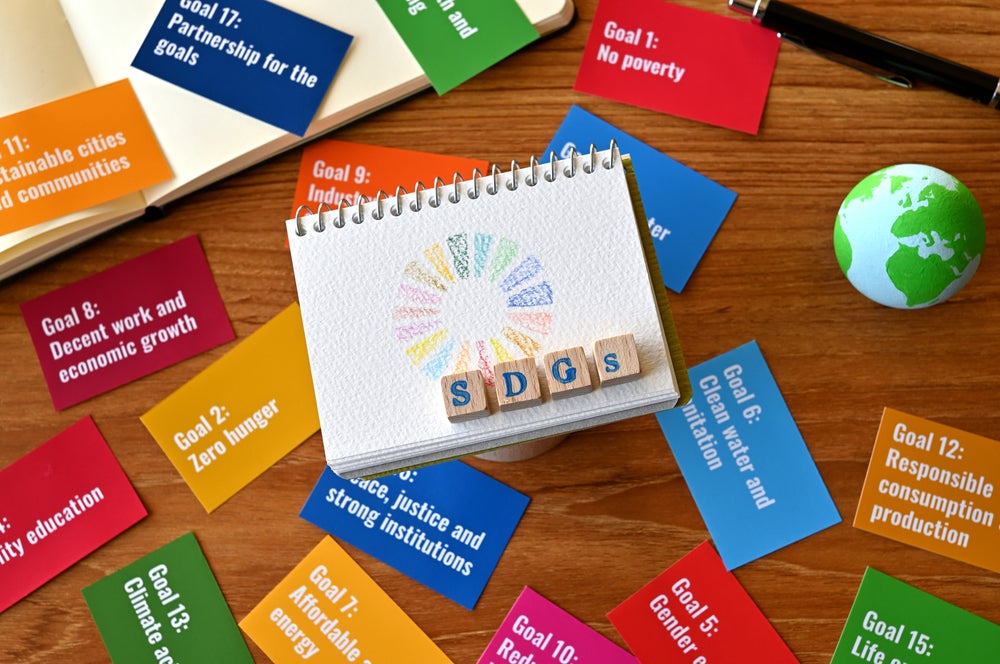
In 2015, the UN identified 17 Sustainable Development Goals (SDGs), asking its members to meet them by a 2030 deadline. Mid-2022 marks the halfway point of hitting these targets, and in many ways reaching them seems as ambitious now as it did in 2015.
Numerous setbacks have hit the SDGs, from the Covid-19 pandemic to the war in Ukraine to the rise of populist politicians (who tend to be more sceptical on issues such as climate change). However, few could deny that progress has been made on many issues identified in the goals. Is this progress enough to meet the SDG targets by 2030, however?
Will the goals be missed?
The 17 SDGs are based around the following:
- SDG1 – poverty
- SDG2 – hunger
- SDG3 – health
- SDG4 – education
- SDG5 – gender
- SDG6 – water
- SDG7 – energy
- SDG8 – employment
- SDG9 – infrastructure
- SDG10 – inequality
- SDG11 – sustainable cities
- SDG12 – responsible production and consumption
- SDG13 – climate change
- SDG14 – life under water
- SDG15 – life on land
- SDG16 – peace, justice and strong institutions
- SDG17 – partnerships
It would seem reasonable to have some idea, some record, of the progress being made towards meeting these goals, seven-and-a-half years after the targets were set. However, little is offered, from the UN or elsewhere. Other questions without answers include: are there any investment tools that could boost the progress towards achieving the SDGs? Why are some countries or sectors progressing faster than others when it comes to meeting SDGs? How is progress towards the SDGs measured?
Unfortunately, there are no easy answers to any of these questions, and what little can be found paints a gloomy picture. Although policymakers, investors, companies and governments across the world are making more and more references to the goals, or pledging their commitments to them, meeting these targets by the 2030 deadline seems unlikely for four key reasons.
First, achieving the same goals worldwide by the same deadline is a tough task as many developed countries have reached some of the them already, while some developing countries lack the necessary resources or infrastructure to even record their progress towards meeting the goals.
Second, as mentioned above, there have been several recent events that have reversed years of progress made towards meeting the SDGs, from global black swan events to the Covid-19 pandemic and the Russian invasion of Ukraine, to their knock-on effects such as the cost of living crisis and supply chain volatility.
Third, some SDGs seem to have a stronger focus than others, or are perhaps more ‘fashionable’, which could potentially result in some goals being overlooked or achieved faster than others. The Company Filings Analytics Trends & Signals Q1 2022 report, a GlobalData study based on first-quarter 2022 earnings call transcripts, reveals that companies tend to refer to different SDGs in their earnings calls depending on the sector in which they operate. In addition, it reveals that there were no mentions made regarding SDG1 (zero poverty) and SDG17 (partnerships) in any of the earnings call transcripts.
Last but not least, there is lack of sufficient data to assess progress made in achieving the SDGs. This is a serious issue as it makes it harder to track any progress or setbacks, to compare the performance of countries and regions with each other, or to provide transparent and accurate information to investors.
Deep diving on SDG data gaps
The World Bank and the UN Environmental Programme (UNEP) are among the organisations that have highlighted the data gap issue when it comes to the SDGs, which raises concerns about how any country can meet the goal targets given that they won't know exactly how they are performing.
A UNEP report, which analysed 92 indicators that are most relevant to the environmental dimension of the SDGs, showed that 58% of indicators did not have sufficient data to assess progress at a global level, as of July 2020.
The report also found that only 23% of the environment-related SDG indicators are on track to meet the target if the current trends continue.
In addition, an article published on the World Bank blog website underlines that there are significant data gaps in assessing country-level progress towards SDGs. More specifically, it is mentioned that “on average, countries had reported one or more data points on only 55% of the SDG indicators for the years 2015 to 2019. No country reported data on more than 90% of the SDG indicators, while 22 countries reported on less than 25% of the SDG indicators." However, the article also stated that countries have improved their data reporting on most SDGs in recent years.
When the SDG targets were set out in 2015, no one could have predicted that in the next seven years the UK would have voted to leave the EU, the likes of Donald Trump and Jair Bolsonaro would be at the helm of major global economies, that many countries would spend months (even years) in lockdown because of a pandemic, or that Vladimir Putin would go as far as he has in bringing the world to the brink of another global conflict.
Those events – and the effects that they have had on issues such as food security and education in developing countries in particular – mean that it is understandable that progress in reaching the SDG targets has been stalled. They also show, however, just how important it is that the world redoubles its efforts towards meeting them. This means that information on how much progress has been made towards meeting the SDGs, and more importantly how countries can improve their efforts to meet them, is of paramount importance. The data gap must be filled.



